Readers of the Mileposts blog hardly need be sold on the close connections between the holiday season and trains, especially in memory. From traveling home by train to see loved ones to seeing snow flying outside the window of a dining car to watching Lionel trains race around a department store window, this season is special to all of us.
With that sentiment, it’s a privilege to offer up the following essay, written by retired railroad executive Lewis Hoy and submitted to me by my good friend William B. Stewart, a veteran contributor to Classic Trains magazine. Hoy’s career included stints as an industrial development executive with the Pennsylvania Railroad, Penn Central, and Conrail. Now in his mid-nineties, he lives in suburban Philadelphia and is doing, Bill tells me.
As Bill reminds me, “it’s a magical season for railroading in all its forms.” Hence what I have for you here, a very touching Christmas traction tale, from the perspective of a youngster who loved Pennsylvania’s Hershey Transit. Until now I was unfamiliar with the HT system, but Hoy’s story, and the photos provided here by the Pennsylvania Trolley Museum, show it to be a railroad as long on charm as it might have been short on economic prospects in its later years.
So, here’s Lew Hoy’s story, which he entitles “Five Days ’Til Christmas, 1946,” described as “a fond farewell to the trolley line built by chocolate candy.” I hope you enjoy it:
“Five Days ’Til Christmas, 1946”
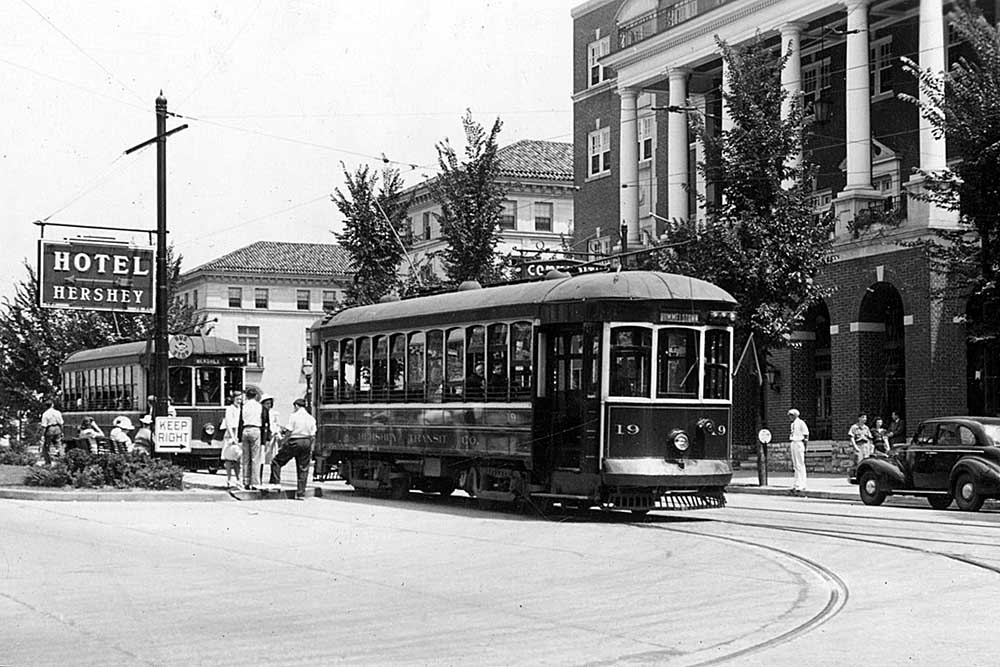
“The war was over, servicemen were coming home, and rationing was at an end — and yet sad occasions still prevailed. In the small Pennsylvania town of Hershey, an old-fashioned electric railway was due to operate its last runs. Abandonment was to have taken place four years earlier, but the line continued to operate in wartime service under an Office of Defense Transportation order issued in the interest of conserving gasoline and rubber.
“The electric railway had been conceived in 1903 as an essential element in Milton Hershey’s plans to create a model industrial community around his new chocolate manufacturing plant. For decades the line had served its purpose well, carrying the company’s employees and the country and town folk along its rural routes. Efficiently, and with great reliability, it fulfilled its equally important task of collecting and transporting fresh milk to the large chocolate factory in a fleet of trolley express motors — at times hauling more milk than passengers.
“Under the shelter of Milton Hershey’s paternalistic chocolate empire, it enjoyed a unique tranquility. It was never troubled by labor strife, nor was it coveted by rapacious traction magnates. Its cars never ventured down teeming city streets, the small system limited to serving the bountiful farm country and the pleasant towns of Dauphin, Lancaster, and Lebanon counties.
“Hershey Transit Co.’s operating standards could best be compared with those of a rural Swiss tramway, an appropriate analogy when one considers that its rural routes passed through rural countryside not unlike that of the Swiss lowlands. In a similar sense, its special flavor was enhanced by the ‘Pennsylvania Dutch’ character of the region, its population including many families of Swiss Mennonite and Amish extraction.
“Hershey Transit’s equipment roster was composed primarily of Brill semi-convertible cars riding on sturdy MCB trucks. The car bodies were turned out in a dignified, dark green livery with gold striping and lettering, all equipment being immaculately maintained to the high standards of Milton Hershey’s properties. The advantages of the Brill design were never more evident than on warm spring days when their great expanse of window area was opened wide to the breezes, the sweet smell of freshly cut alfalfa drifting in from the fertile dairy lands through which the railway passed.
“It was expected that the end of Hershey Transit’s service would occur as soon as replacement buses could be obtained. When the word came, it was still with some suddenness — in my case, in the urgency of a phone call from a friend in Palmyra, Charlie Butler, informing me that Hershey’s management had decided to end service ‘…at the end of the week, Saturday, Dec. 21st!’ He said the employees were upset; they had hoped to operate through one last Christmas season — at least until the end of the year. It was a disappointment eased only by the knowledge that the veteran personnel would retire as Hershey employees, the remainder to have jobs elsewhere with Hershey’s interests.
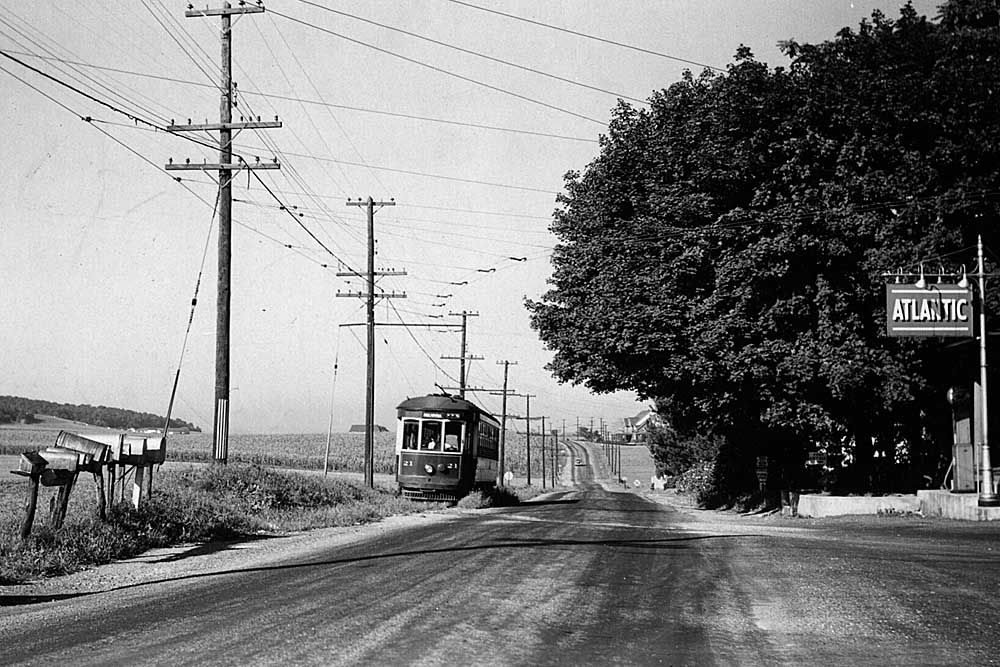
“On Dec. 20, a snow and sleet storm swept across the region causing a major disruption in highway travel, including a near shutdown of local bus service. A newspaper reporter’s call to Hershey Transit concerning the impact of the storm on its service brought the response, ‘All routes operating, but with delays.’ During the storm, a replacement Hershey Coach Co. bus, on a driver training run, skidded off the road and received minor damage.
“The trolley company’s elderly snow sweepers had been moved out of the barn and prepared for service, but they were not used, the railway’s problem being ice-coated overhead wires. Sleet cutters were applied to the trolley poles of regular service cars while the line crew worked to keep the overhead clear.
“The dawn of Dec. 21 revealed another dark, snowy day. In my hometown of Schuylkill Haven, I pleaded with my somewhat reluctant father to undertake a 40-mile drive to Hershey. As a veteran automobile man, he admitted that he had ‘seen worse.’ He was also known to view such events as a challenge. Plus, he had a sentimental tie to Mr. Hershey’s enterprises, on occasion recalling that Milton Hershey had periodically visited my grandfather’s general store in his early efforts to sell his candies. Whatever my father’s motivation, he agreed to make the nasty winter’s journey.
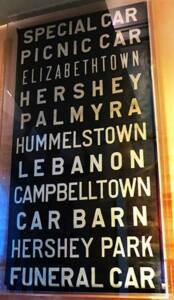
“We drove to Palmyra, met Charlie Butler, rode the Hershey lines and stopped at the car barn in the hope that I could obtain a destination sign as a souvenir. I received a rather brusque rebuff from Superintendent Flowers, usually a very hospitable man. But the story ends well. In the office was Miles Lebengood, general manager of the Hershey Coach Co., whom I knew. He quietly advised me to wait outside.
“In a few minutes he returned with a sign and commented, ‘It’s a difficult day for Mr. Flowers. He had hoped that Hershey Transit would run the bus service.’ Unhappily for Mr. Flowers, Hershey’s management had chosen to exit the transit business. Hershey Coach, a subsidiary of the Reading Street Railway, would provide the replacement bus service. Mr. Flowers was assigned the job of manager of the Hershey Arena ticket office with the closeout of Hershey Transit’s business.
“There was a certain satisfaction in the knowledge that the public would fill the cars on the final runs, with longtime patrons turning out to say goodbye to the familiar cars and their veteran crews. All last trips, with the exception of the Campbellstown run, were operated with two-man crews that night. A few short years later, the buses of Hershey Coach would disappear from the local highways without ceremony, victims of the same relentless automotive tide.
“Societal issues aside, the passing of the Hershey trolleys was evidence of something else being lost — a form of transportation sensitive to its environment. The thought occurs that this small electric railway immeasurably enhanced the quality of life in its service area without damaging or despoiling the area through which it ran, so gently was it laid across the landscape. This was a great part of the beauty of the line.
“We shouldn’t shed tears for inanimate objects, but as my dad and I drove away from the end of the car tracks in Palmyra on that dark winter’s day I confess that I had a lump in my throat knowing I’d never experience such a trip to Hershey again. I equate the feeling to that of someone who sees the old family homestead being demolished, a place where the memory of family, friends and neighbors and the experiences shared with them seems to inhabit its very walls.
“In my memory, Hershey Transit’s green cars hold some of that aura for me. They will always be associated with family picnics at Hershey Park, tours of the chocolate factory, and visits to a town where the smell of roasting cocoa beans was heavy in the warm summer air.
“We didn’t stay for the final runs, leaving for home before nightfall. I had paid my respects. My dad had driven that extra, slushy mile for me. I couldn’t have expected more.”
Thanks to the Pennsylvania Trolley Museum of Washington, Pa., for supplying images for this article.






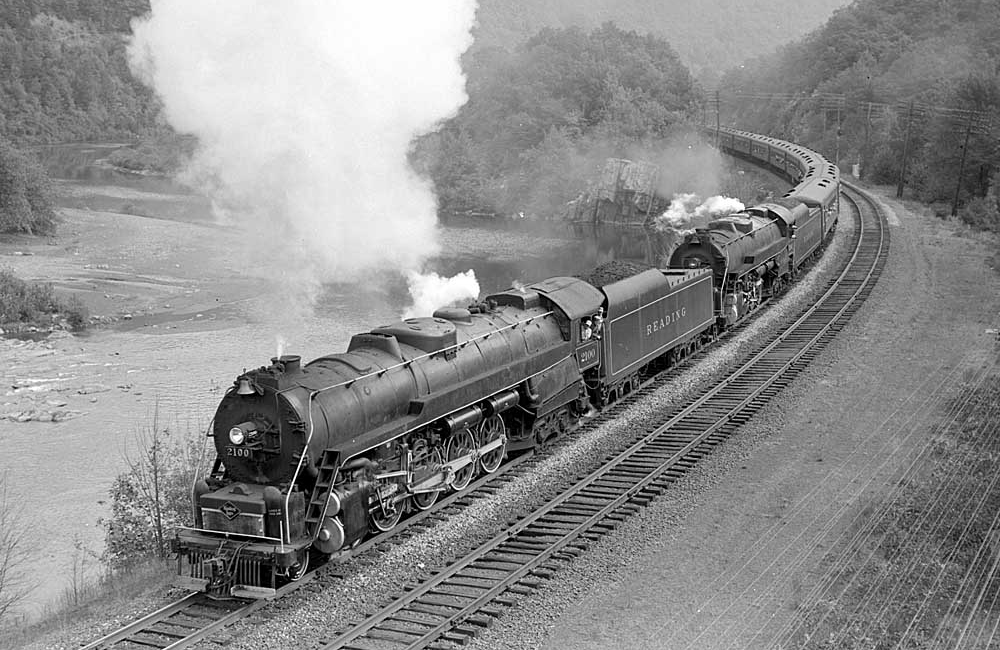
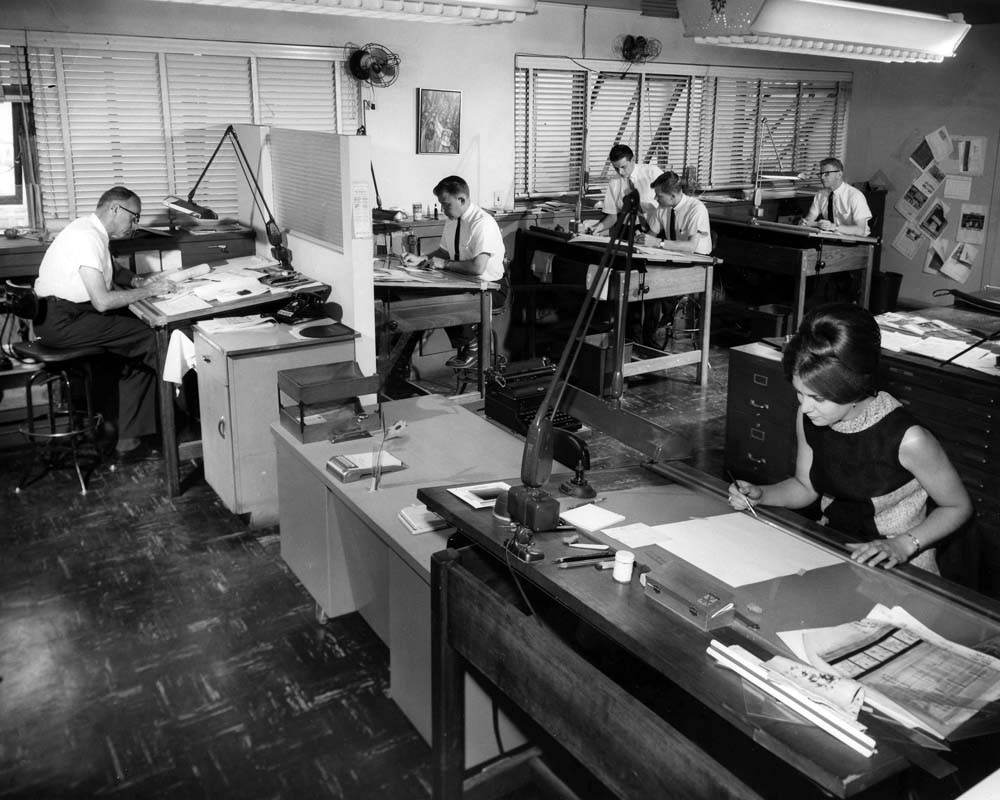
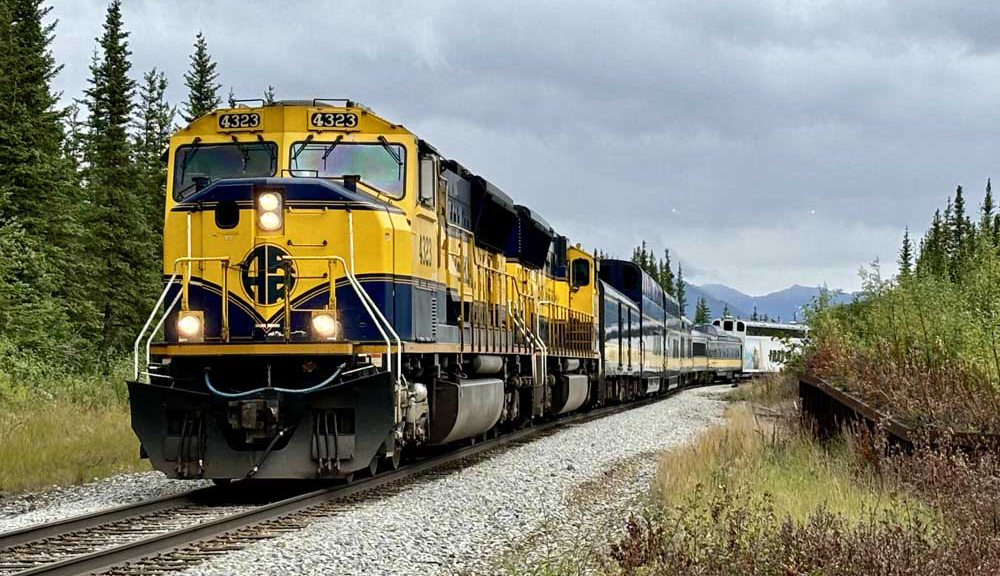
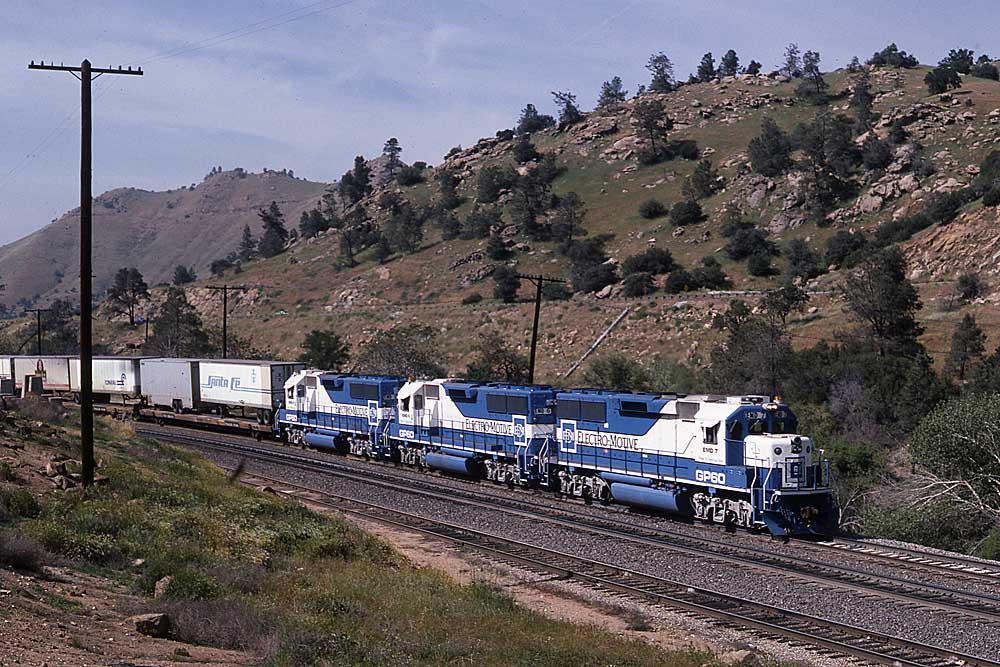




Keefe, I sooooo look forward to your posts & blogs. Dunno why it took me decades to finally subscribe to CLASSIC. Keep up the great writing, Merry Christmas. The Hershey Transit system story was just what I needed today!
Our streetcar system in Lincoln, Neb., almost all bus by 1942. Conversion of the last two lines was delayed by the federal order, but they were promptly bused on Sept. 2, 1945. They even had to get an ODT waiver, but at this point the war was over. It was a National City Lines property by then.
Correction. Last day for the Lincoln streetcars was Sept. 1, 1945. It was the first postwar conversion in the nation.